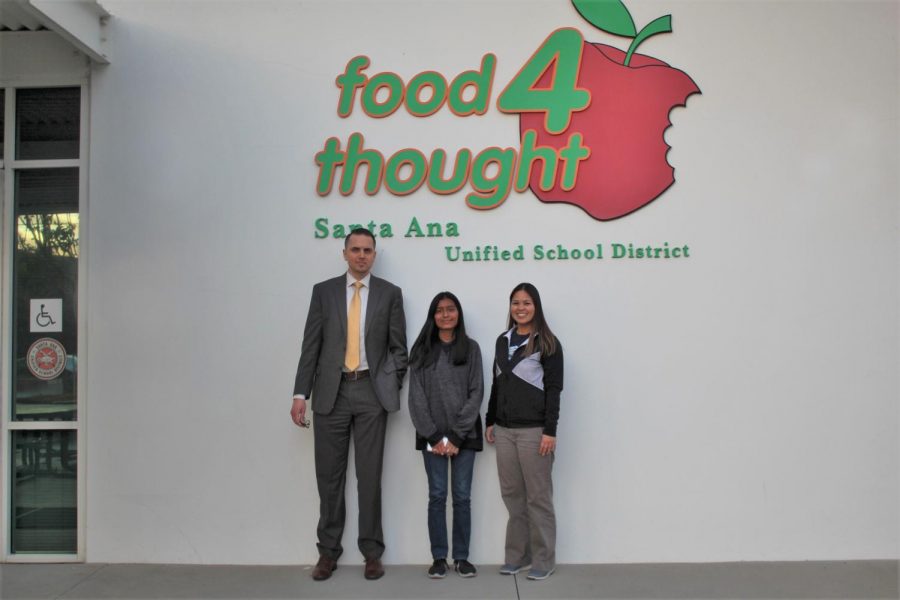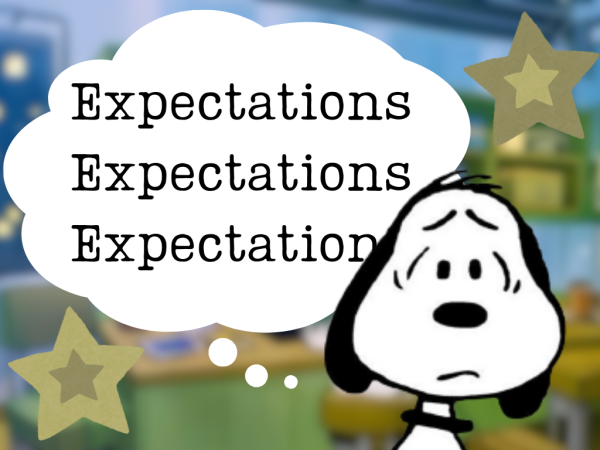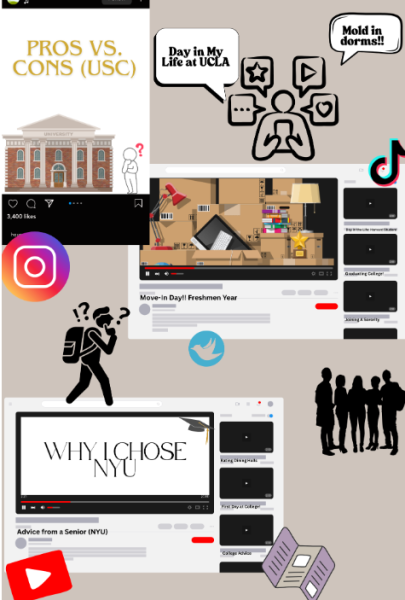Nutritional Services has many plans in mind to accommodate student food needs
From left to right: Assistant Director of SAUSD Nutrition Services Josh Goddard, News Editor Emily Corona, and Nutrition Specialist Tracy Zoleta discuss students’ food needs.
If you have had a complaint about the food you are served at school, it is likely other students share the same feelings.
Although students may think school lunch food isn’t of much importance to their school district, the truth is there is about a group of 400 staff members on board preparing school lunch meals.
Not only is this team ensuring students get a filling, nutritious meal, but they also attend food shows and visit schools’ sites to perform food tastings to discover student food needs.
Mr. Josh Goddard, Assistant Director of the Santa Ana Unified School District Nutrition Services speaks on behalf of ideas on the table.
Their mission: “Provide safe and nutritious meals to students in Santa Ana to promote wellness and healthy eating habits.”
OC Food Access Coalition 2017 statistics state that “nearly 350,000 Orange County residents struggle to get their food needs met on a regular basis, and the number is growing. This isn’t for lack of available food in our community but for lack of access to affordable, good food options for low-income residents.”
According to the USDA food security reports: Food insecurity is a household-level economic and social condition of limited or uncertain access to adequate food.
Intermountain Healthcare also provides another more commonly known definition: Food insecurity is when someone lacks consistent access to affordable, nutritious food they need to live a healthy, active lifestyle.
Mr. Goddard was asked if he believes there is a food insecurity crisis in our community.
“It is a major issue, in this city, in this region. It is a serious problem in Santa Ana.”
Voice of OC 2013 article states that “nearly a quarter of Santa Ana’s residents are affected by food insecurity, and countywide more than 155,000 children are lacking regular access to nutritious food.”
When asked what SAUSD is doing to combat this issue, Mr. Goddard explained.
“This school district is under the community eligibility provision where no matter what your status is in terms of whether you qualify for a free, reduced, or paid meal, everybody in this district eats at no charge for breakfast, lunch, and after school. Our after school supper program is open to anybody. You don’t have to be enrolled in the after school program. You could simply stop by if you wanted to on your way home and grab a supper kit.”
They also offer this service during the summer break.
“During the summer we offer the Seamless Summer Feeding Option which is a federal program; it is an extension of the national school lunch program. We are on about 60 different sites and it is completely open to the public. We do about 10 parks where the program is completely open to the public. That’s our contribution to fighting food insecurity in Santa Ana.”
Junior, Cristina Pate responds to SAUSD’s contribution to food insecurity.
“Personally, I think that SAUSD is doing a lot to help students that might be facing food insecurities. I am glad that they offer free breakfast and lunch and MCHS. Other schools outside of this district have to pay for their school lunch, and I am glad that we are fortunate enough to eat for free.”
Addressing student concerns
Nutrition Specialist, Ms. Tracy Zoleta says leftover food from school lunch is not thrown away.
She said, “We are working with Waste Not OC which is an outside organization that picks up leftover food from you guys [school sites] and delivers it to nearby shelters or community centers, pantries, and food banks. We are only doing this with four of our schools right now, and actually Middle College is one of them.”
Ms. Zoleta describes how this work is expected to expand in the future.
“The issue is the distribution model. The partner we work with, Waste Not OC is linked to pantries. They are 501(c)(3), so they are a nonprofit and they are the ones who connect us with these pantries or food banks, but they also provide the transportation of that food. Their limit was four schools as for what they could handle logistically. Now they are identifying other resources enabling us to broaden this to more schools. So more schools will be participating in the very near future.”
She continues to describe another program nutrition services has implemented.
“And we participate with the Caring Educator Nourishing All (CENA). It is an event we do on Christmas Eve every year. it’s my seventh year doing it. We serve about 3,000 members of the community on Christmas Eve. We hand out gifts, lunch for the families, give out books, and give out big bags of food. As we end our semester for winter break, we have a lot of food on hand that won’t make it the two weeks that we’re closed. So our program that produces 5,000 meals a day completely stops, and we have all this food that will expire before the break ends. So we donate it to CENA and it goes to the hands of families that could use it over the holidays.”
This isn’t the only thing they’re doing to reduce waste.
Being environmentally friendly
Mr. Goddard has heard the voices of students.
“I actually had a meeting this Wednesday morning with Harver elementary school. They wrote me a couple weeks ago asking what we were doing to reduce our carbon footprint. I shared with them that we are looking into it. We are trying to source a compostable or wooden spork right now. The two biggest issues that we see are cost because they are so much higher than what we currently pay for our plastics. The other obstacle is the way we dispense it.”
He continues to describe ways they are reducing waste.
“We are actually piling on a program at Martin Elementary where we are getting rid of the spork kit and we are going to put out dispensers. This should enable us to reduce the amount of waste that we create because if a student just wants one of the four things [in the spork kit], they just take that.”
Senior Brandon Garcia appreciates Nutrition Service’s plans to make school campuses more environmentally friendly during lunch.
“I agree with Mr. Goddard’s response. Here on campus, I see a lot of the spork kits being wasted just because a person only wants the napkin or straw and then throws away the rest of the kit. These dispensers would reduce the amount of plastic currently being used. Along with this, it would also help lower the trash floating around the campus. During our campus cleanups, the most abundant trash that we see are straws, sporks, and the plastic wrappers. Hopefully we get dispensers that would reduce this waste that is affecting our school community.”
SAUSD Nutrition Services will continue efforts to be environmentally friendly.
“We are definitely looking into it, and hopefully get it mobilized to a higher degree in the very near future.”
The school lunch menu
When students receive lunch they don’t enjoy, they can’t help but wonder, “Who decided today’s food menu?”
Ms. Zoleta describes the process of menu creation.
“Our number one is student input. We try to do as many taste tests as we can and try to do small taste tests in schools like in Costco, per say. We try to do that every once in a while. We just did one at Esqueda and sampled something that is going to be new on the menu.”
Nutrition Services also gets student input from feedback students voice to their school site staff members.
Aside from student input, Ms. Zoleta also looks for parents’ feedback.
“Every once in a while we will have the opportunity to meet with parents and they will give us feedback that they hear from our students as well.”
They also attend food show events.
“We went to a food show last week and we had vendors come at us all the time saying ‘try these foods, try these foods. We know your kids will love it’ and we were like ‘Uhhh, we know our kids.’ So we make sure that whenever we do get new items, we share it with you first.”
Aspiring future school lunch menu
Nutrition services are aware of students with dietary restrictions.
“I think about vegans everyday because I am a vegan. Just two weeks ago, we brought in a soy-based nugget. We are in the process of identifying other products that would work to market/promote to the rest of the student body,” Mr. Goddard said.
Ms. Zoleta describes how milk alternatives might be available.
“The milk that we offer has to have the same nutrition profile of cow’s milk. Unfortunately right now, based off the meal pattern, that’s all that we can offer unless you have a specific note that says you cannot have cow’s milk. Then we could offer a soy milk or a lactose-free milk, but that’s basically it.”
If a student cannot drink the milk provided, Nutrition Services recommends filling out a medical note and fill out a medical statement so they could ensure they provide you with that.
In regards to students voicing their dietary restrictions, Mr. Goddard says, “We definitely heard that message loud and clear. It is something that geared us and we want to be responsive to this group.”
Sophomore Natalia Leon is glad SAUSD is making efforts to accommodate student food restrictions.
“I personally think Nutrition Services is taking that extra step for those who don’t speak up for their food needs. Some students don’t eat until they get home. They are including everyone like vegans and vegetarians. I feel like it is important for all vegetarians to feel welcomed and have a place to eat and know that school officials think of their health when serving lunch. Overall, I think it is a great thing that they are thinking of future plans with their food options.”
If you are a student with food needs that haven’t been addressed or accommodated to meet your restrictions, nutrition services is open to listening to you and making sure you get an adequate school lunch.
Nutrition Services’ final message to all Santa Ana Unified School District students:
“Everything we do is for you guys. You guys are our number one priority. I think that our team is, all 400 of us, amazing. We work really hard for you guys everyday; completely student driven. Whatever you guys want we intend on responding to it. Social media is a platform we are responsive to and we listen. Share what you want and we’ll do our very best to respond to it because we are here for you.”
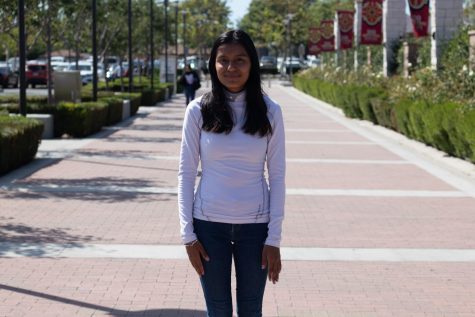
Fun Facts:
I have a cat named Bootz.
Freddie Mercury is da best.
My favorite club is Wizards for Water.
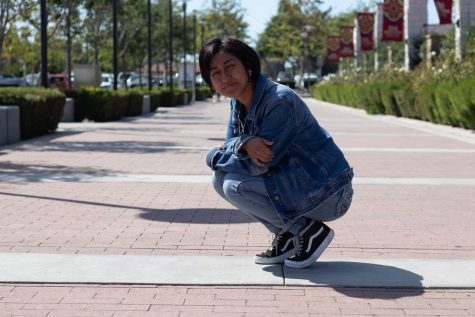
Fun Facts:
I'm really blind.
I love Erik Le <3.
I love drinking coffee.

































